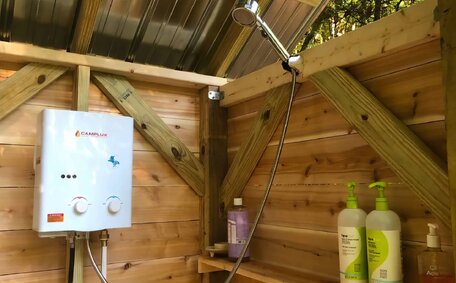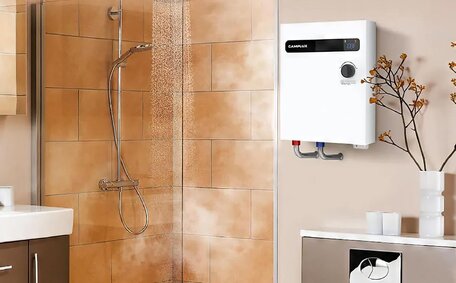Introduction to Your Water Heater’s Pilot Light
The pilot light, a small flame within your gas water heater, activates the main burner to supply hot water on demand. This mechanism enables immediate hot water supply, eliminating the need to manually ignite the burner repeatedly.
If the pilot light goes out, it prevents your hot water system from functioning properly. An extinguished pilot light may result in a complete lack of hot water or insufficient hot water production.
Relighting an extinguished pilot light is usually a simple process most homeowners can handle. At Cranebrook Plumbing, we want to empower you to relight your pilot light confidently, and determine if professional assistance is necessary.
Safety First: Turning Off the Gas Before Relighting
When dealing with gas appliances, safety should always be the top priority. Before attempting to relight your water heater’s pilot, it is crucial you turn off the gas first.
Turn the gas shutoff valve, located next to the water heater, clockwise to the ‘off’ position. Give the valve a gentle pull to ensure it’s firmly closed. Wait 5-10 minutes before proceeding, allowing any residual gas fumes to dissipate.
It’s normal to detect a slight gas smell when you first turn off the valve, but if the odour lingers or intensifies, vacate the area at once. Do not relight the pilot or turn the gas back on. Instead, contact our team at Cranebrook Plumbing on 1300 349 338 to schedule a gas leak inspection.
With the gas confirmed off and no gas leaks present, you can safely access the pilot and relight following the appliance’s instructions.
Locating and Accessing the Pilot Light Assembly
First, access the pilot light assembly to start relighting your water heater’s pilot. Refer to the appliance’s manual or the label affixed to the heater for a diagram showing the pilot location and any special instructions.
Typically, the pilot light is positioned at the bottom of gas water heaters, protected by an access panel that may be unscrewed or slid open. Remove this panel to reveal the pilot assembly encased in a metal box, complete with a viewing window.
If there is no visible access panel, the pilot assembly may be located underneath by the main burner tray. Gently pull off any protective cover to get a clear view of the pilot light.
Be cautious to avoid harming thermal couplings, tubing, or wiring when accessing the area. Only proceed with relighting if you have confirmed there is no gas leak and the area smells clear after shutting off the gas valve.
Understanding Pilot Light Components
The main components that make up your water heater’s pilot light system include:
- The gas control valve – This knob controls gas flow to the pilot assembly and burner. Turning it to the ‘pilot’ position prepares the system to be lit.
- The thermocouple – A heat-sensitive device that generates a small electrical current to signal the gas valve to stay open when heated by the pilot flame.
- The igniter – Creates a spark to light the gas and ignite your pilot. This may be a push-button piezo igniter or an electronic igniter.
- The pilot burner – Emits the small pilot flame to signal the thermocouple to keep gas flowing to the main burner.
Understanding how these components interact is crucial for a successful pilot relight. The igniter produces a spark that ignites the pilot gas. This small flame heats the thermocouple, which in turn signals the gas control valve to stay open.
Step-By-Step Guide to Manually Relighting the Pilot
If you have confirmed there is no gas leak, follow these steps to manually relight pilot on your water heater:
- Ensure the gas control valve is turned to the ‘pilot’ position. This restricts the gas flow solely to the pilot light.
- Continuously press the igniter button for up to 90 seconds, while positioning a long lighter or lit match near the pilot light housing.
- When the pilot flame ignites, keep holding down the gas control for 30-60 seconds to allow the thermocouple to heat up and signal the gas valve to remain open.
- Release the gas control button. The pilot flame should now remain lit. Confirm this by ensuring the indicator light on the valve stays on.
- If the pilot doesn’t ignite initially, repeat steps 2-4, ensuring all gas valves are fully open. It may take a few ignition attempts to clear the gas line and heat the thermocouple.
- Once the pilot flame remains lit, resecure any access panels, then slowly turn the main gas valve back to the ‘on’ position to restore hot water function.
Following these steps should enable a hassle-free manual relight of your water heater’s pilot light. However if these attempts fail, or the pilot repeatedly goes out, contact Cranebrook Plumbing on 1300 349 338 to schedule a comprehensive diagnostic.
Using Electronic Ignition Systems
Many modern gas water heaters feature an electronic ignition system that simplifies the process to relight pilot instead of a manual piezo igniter. This uses an igniter button powered by a small battery that creates an electric spark to light the pilot.
Locate the electronic igniter button near the gas control valve. It may be marked with a lightning bolt symbol. Press this button firmly for 1-2 seconds, keeping your head away from the pilot box as the spark ignites.
Listen for the snapping sound indicating the electric spark’s attempt to ignite the gas. Repeat pressing the igniter button every 2 seconds until the pilot flame ignites. As with manual systems, hold the gas control knob down for 30-60 seconds once lit before releasing.
Repeated pressing of the electronic igniter over 20-30 seconds is often necessary to ignite the pilot flame. Remain patient and keep trying, attentively listening for the sparking noise.
If the pilot fails to ignite after 1 minute of attempts, turn off the gas valve and wait 10 minutes before reattempting. Check that batteries are fresh and inserted properly.
Electronic ignition simplifies the relighting process, making matches or lighters unnecessary. However, manually lighting is still possible if the electric ignition fails. Contact our team for assistance troubleshooting temperamental electronic and manual pilot systems.
Troubleshooting Issues with Keeping the Pilot Lit
If you have successfully lit your water heaters pilot light but find it repeatedly goes out after releasing the gas control, Before contacting a professional, consider several troubleshooting strategies.
Check the pilot housing for drafts that could extinguish the flame. Close windows and doors, fill any gaps in external ventilation, and if required, use a windguard around the pilot area.
Examine the area for dirt, dust or debris that may interfere with the pilot’s components, causing it to shut down. Gently clean the thermocouple and piezo igniter using a soft bristle brush.
You can also test the thermocouple with a multimeter to check for a minimum of 30mV output when heated. If not reaching this output, replacement of the thermocouple may be required.
Should the pilot light continue to extinguish after troubleshooting, ring Cranebrook Plumbing at 1300 349 338 to avert potential gas leak hazards.
When to Call a Professional Plumber
If you smell gas persistently, it’s crucial to contact a professional plumber immediately. An unaddressed gas leak presents a serious risk, with the potential for hazardous consequences. Don’t hesitate - call Cranebrook Plumbing on 1300 349 338 right away.
If you need to frequently relight pilot lights after they go out, professional assistance is recommended. There may be an underlying issue preventing the pilot from staying lit, like a faulty thermocouple, draftiness, or problems with electronic ignition components. Attempting repeated DIY repairs risks safety.
Should the water heater not heat efficiently despite a lit pilot light, the main burners might need cleaning or service. Our licensed technicians possess the expertise and equipment to thoroughly inspect your system, ensuring your hot water is restored to optimal functioning.
For ongoing pilot light or water heater concerns, rely on the expertise of Cranebrook Plumbing’s professionals. Contact us at 1300 349 338 or [email protected] to troubleshoot your problem and decide on the best solution.






